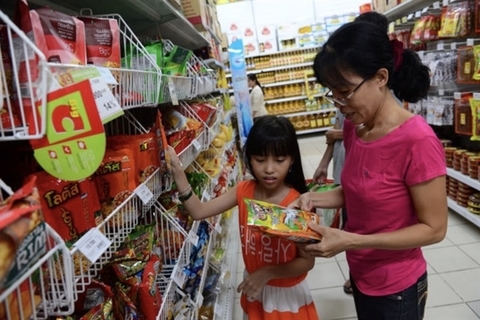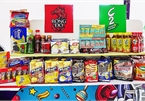 |
|
Customers buy snack at the supermarket. Snacks are replacing traditional meals.
|
A survey of the market by The Harris Poll and Mondelez International in 12 countries found six out of 10 preferring to eat many small meals throughout the day as opposed to a few larger ones.
That number rises to seven in 10 among millennials.
About 76 per cent of parents use snacks to pass cultural snacking rituals on to their children.
In the Vietnamese market, snacks are sold at both traditional retail shops and convenience stores.
Last year Nielsen released a report on 2017 which said while the fast-moving consumer goods (FMCG) segment saw volatility in sales growth, one category showing ample growth opportunity was snack foods.
Nielsen surveyed both traditional and modern trade channels and found that the sales of food increased by 7 per cent and contributed 16.3 per cent to total FMCG sales.
However, a closer look found the growth of regular categories like instant noodles, soy and oyster sauce, fish sauce, and MSG was not as fast compared to impulse categories such as biscuits, cake pies and snacks, especially snacks which grew at 21 per cent.
A company executive said: “Snacks foods in many markets around the globe enjoyed significant growth thanks to increased appetite for snacking products. This impressive growth in so-called indulgence or non-essential categories is a good indicator that consumers in many countries are willing and ready to spend beyond the daily necessities, creating a good opportunity for FMCG companies in these markets.”
According to a recent study by Kantar Worldpanel, which deals in consumer knowledge and insights based on continuous consumer panels, the Vietnamese snack market, which was valued at US$518 million in 2015, is expected to grow to $1 billion by 2020.
A seller in District 7 said snack sales are increasing as students and office workers buy to eat during breaks.
He also said that the market is becoming increasingly diverse with many new products being launched by both domestic and foreign companies.
Snack company Mondelez Kinh Do said there an increasing number of people in Viet Nam, especially youths, are looking for high-quality and more convenient products, and willing to spend more on certain high-value foods.
Besides, the rising number of women in the workforce leads to increased snacking behaviour while working mothers need products and brands that they feel comfortable about giving their children, the company said.
The company’s managing director, Hemant Rupani, said the Viet Nam snack market has great potential. Seeing this, the company is researching to bring new products, including some made exclusively for the country, he said, adding it is also expanding to rural areas.
A woman who asked not to be named told Viet Nam News since she is very busy and her children have many classes to attend snacks are a good choice for both.
“Sometimes I don’t have time to go to the market or cook, and so snacks are good for us. There are many good snacks.
“Besides, manufacturers have started to make snacks that are good for people’s health like low-calorie items and snacks for people with diabete.”
The Vietnamese market has attracted foreign companies from all over the world. — VNS

Growing appetite for quality snacks
Local snack producers in Vietnam are ramping up operations to tap into the growing demand amid changing eating habits.

VN snack exports have huge potential
Vietnam’s snacks made of farm produce could conquer foreign markets, especially China, experts say.
 Snacks are replacing traditional meals as busy modern life changes consumer behaviour, making the snack market lucrative globally including in Viet Nam, experts said.
Snacks are replacing traditional meals as busy modern life changes consumer behaviour, making the snack market lucrative globally including in Viet Nam, experts said.